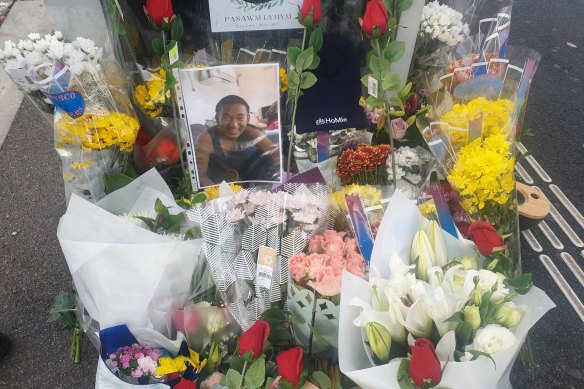Agencies need support to tackle violence in schools

Save articles for later
Add articles to your saved list and come back to them any time.
Australians have long looked on in disbelief and horror at school shootings in the United States and been grateful that they live in a society where they can send their children to school knowing them to be safe from life-threatening violence.
That sense of security must be a minimum standard for any community. But while the tragedy of America’s gun culture is not the yardstick by which we should measure ourselves, it does offer a moment of pause when complacency might leave us deaf to alarm bells close to home.
A tribute to Pasawm Lyhym at the bus stop where he was fatally stabbed.Credit: Nicole Precel
Two weeks ago, Pasawm Lyhym was hanging out with schoolmates at a bus station in Sunshine when a fight involving what police say were groups from different schools broke out. Pasawm, a year 11 student at Staughton College in Melton South, was stabbed and died at the scene. He was 16.
Detective Superintendent Janet Stevenson said teenagers who arrived at the station “looked as if they were there for a purpose”, and at least three of them were armed with knives. Two other boys were injured in the stabbing incident.
This week, a 17-year-old boy faced a children’s court charged with murder over Pasawm’s death. He is yet to enter a plea and the criminal case has only just commenced.
Data from the Crime Statistics Agency revealed in The Saturday Age today shows that the kind of violence that led to the death of Pasawm is on the rise in schools and education locations in Victoria.
In the past five years the number of children aged 10 to 16 accused of committing serious assaults in education locations in Victoria – which can include public and private schools, school grounds and other educational areas – has soared 45 per cent.
The CSA data on serious assaults, which includes assaults of emergency workers such as police, reveals the number of accused rose from 129 in 2018 to 187 in 2022. The statistics represent assaults that occurred during and outside school times.
Disturbingly, youth workers and school support agencies who are engaged at the front line of this troubling trend say the data reflects a rising wave of knife crime and an increase in the number of younger students carrying knives – either out of fear for their safety or because it has been glorified on social media.
The death in 2020 of 15-year-old Solomone Taufeulungaki, who was fatally stabbed on his way home from school during a brawl in Deer Park, and the alarm that it raised, has not deterred students from carrying and using these potentially lethal weapons.
In late February, a student allegedly stabbed another in the neck at Reservoir High School, and last year a Traralgon Secondary College student waved a knife at school. Between January 10, 2022 and January 10, 2023 there were 78 incidents involving weapons in Victorian state schools, according to information obtained through freedom of information from the Department of Education.
Teacher union representatives say that much of the student violence is directed at other students, but there has been a spate of injuries inflicted on teachers and staff by students.
This is an unsustainable situation. The Education Department says violence and aggression are not tolerated in Victorian schools, and there are processes in place to deal with incidents, including reporting them to Victoria Police. Victoria Police says it takes all reports of crime seriously and encourages schools to report incidents immediately.
There are echoes of the response to school violence in the United States in the calls from some Victorian parents for schools to implement bag searches for weapons or for security guards to be employed to keep students and teachers safe.
Parents in Shepparton want protective service officers to patrol a large bus interchange used by students from eight schools that has been the scene of recent violent incidents.
These types of measures are not favoured by police or the Education Department, and they are not part of the educational landscape that Victorian parents would want for their children.
Groups such as Victoria’s Youth Support and Advocacy Service say the problem is too big and too nuanced for schools to deal with on their own. The service’s crime prevention manager, Navin Dhillon, who works in Melbourne’s north and west, says a co-ordinated response is required.
Youth worker Hanad Hersi, who has seen “shocking” violence within schools, is calling for a multidisciplinary approach in which schools, police, youth workers, community organisations and local councils work together to protect students and mitigate violence.
The impact on young Victorians of COVID-19 lockdowns, which Hersi says has caused many students to become disengaged, must be a focal point. To that end, the state government has invested more than $600 million into mental health in schools, with a mental health practitioner in every government secondary and specialist school.
It is a good start, as is a school engagement model launched by Victoria Police in 2021, which involves specialist and frontline police working with schools to deliver crime prevention and safety messages to primary and secondary students. The Youth Support and Advocacy Service is running a pilot program with a large school in Melbourne’s west that has a youth worker visiting weekly to engage wellbeing officers.
The state government must play a greater role co-ordinating the institutions that have the expertise to tackle the causes of this growing violence, and deliver a strategy for prevention as well as protection. The alarm bells are ringing.
Patrick Elligett sends an exclusive newsletter to subscribers each week. Sign up to receive his Note from the Editor.
Most Viewed in National
From our partners
Source: Read Full Article
